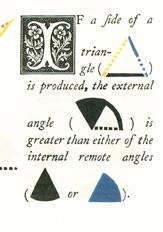
Max Planck Research Group (2010–2016)
Research Group Leader Vincenzo De Risi
Modern Geometry and the Concept of Space
This Research Group explored modern geometry and the concept of space. Although a divide between ancient and modern geometry can be framed in different ways, the most useful one may well be the emergence of the consideration of space itself as an object of geometrical investigation. Greek mathematics understood geometry as a study of straight lines, angles, circles and planes, or in more general terms as a science of figures conceived against an amorphous background space whose definition lies outside the limits of the theory. This understanding was superseded by a conception of space (and spaces, now plural for the first time) itself endowed with geometrical properties. The main concern of this new geometrical science is to characterize the structures and features of geometrical space in axioms and demonstration. Although it is quite clear that this revolution in geometry helped shape the scientific world such that contemporary mathematics remains incomprehensible without it, the questions of when, why and how this revolution took place, prior to this research, were still to some extent obscure.
The earliest record of a geometrical understanding of space itself is probably to be found in some Renaissance treatises on perspective, and then in Pascal’s pioneering studies on the geometry of projections. The first comprehensive and conscious attempt in a new science of space, however, appears in the hundreds of Leibniz’s essays on the analysis situs, in which the philosopher tries to define space and its properties axiomatically, and to link Euclidean axioms to the very definition of space. A century and a half later, this geometrical understanding of space had become commonplace: non-Euclidean geometries and projective techniques form part of mainstream mathematical research, and a modern conception of space and spatial intuition has helped reshape pure and applied science, philosophy, and even the visual arts. Against this background, the research group aims to reconstruct this 150-year-long mathematical, philosophical, scientific and cultural revolution, from the time the ancient view of geometry as a science of figures and magnitudes began to fracture to the flowering of a full-fledged expression a genuine science of space.
The aim of the Research Group was to bring together scholars in different disciplines to construct a comprehensive picture of the developments that gave rise to contemporary geometry and the modern concept of space. The main body of research naturally focused on the history of mathematics itself, since this history registers, year by year, the core developments in the field. The very nature of the investigation, however, encourages a more complex and structural approach. This includes an analysis of eighteenth-century developments towards a geometry of projections, which could reveal how the idea of a plurality of spatial structures can be traced from the followers of Desargues to Monge and Poncelet. This approach could be fruitfully combined with parallel research into other interconnected fields whose development sheds light on the growth of mathematics, such as optics, the physiology of perception, the philosophical debate about the theory of vision (in Berkeley or Reid, for instance) or the different space-sensoria in general (e.g. the quarrel about Molyneaux’ s case).
A different line of research drew on the prehistory of non-Euclidean geometries in the eighteenth century (e.g., Saccheri or Lambert) and the beginnings of philosophic reflection on the topic (Reid, Lambert, and others). Also explored was the the contribution made by the development of mechanics to the concept of space, in the Newton-Leibniz controversy and its consequences, and the effect of this new geometry on physics itself. Kant’s famous synthesis of these debates in his writings about space and geometry was also considered.
